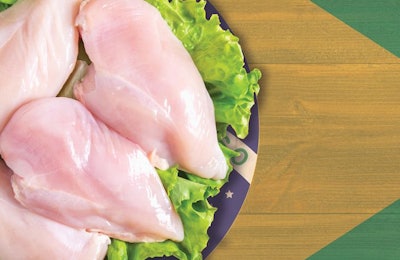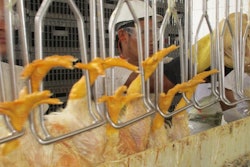
Brazilian poultry meat production could reach a new high of 14.5 million metric tons in 2021, an increase of 5.5% compared to 2020.
Forecasts made by the Brazilian Association of Animal Protein (ABPA) in December 2020 suggest that, despite difficult market conditions, both production and exports will be higher in 2021, with the latter forecast to increase by 3.5% to reach 4.35 million metric tons. Per capita consumption on the home market, which accounts for the bulk of industry sales, is expected to rise by 4.4%.
Positives
According to ABPA president, Ricardo Santin, there are a number of positives ahead for the Brazilian industry.
Speaking in December 2020, he noted that demand from Asia for Brazilian poultry meat should remain at elevated levels during 2021, helped by the return of a number of important importers, such as the Philippines.
July 2021 will see Japan host the Olympic Games, which should boost demand for Brazilian chicken, the country already being a key export destination.
Mexico will also be a key focus for Brazilian product in 2021.
Additionally, Santin cited the economic recovery as COVID-19 is gradually brought under control as a further stimulus for poultry meat demand.
Challenges
Nevertheless, the Brazilian industry, like others, will face a number of challenges.
Despite vaccination campaigns having started in some parts of the world, COVID-19 will continue to put pressure on food service and trade, and growth will take time to restore the global economy to its pre-COVID-19 levels.
According to Rabobank, global trade will be competitive, with prices for legs and breast meat expected to remain low. The first half of 2021 is expected to be particularly challenging.
China and other African swine fever affected countries such as the Philippines have been a safe haven for global poultry exports during a difficult year. China’s import volumes doubled in 2020 due to low availability, especially during the first half. Export volumes to the Philippines and Vietnam also increased. However, imports have been dropping in most markets, such as the European Union, Saudi Arabia and Japan.
While Brazil may have been able to ride these changes, compensating for low exports to Europe and the Middle East by selling more to China, it will need to find new markets, Rabobank notes. For example, Saudi Arabian and Japan, the second- and third-largest importers of Brazilian poultry meat, reduced their purchases by 4% and 23%, respectively.
Production costs have risen in the country, especially feed prices, and could will pressure margins. Despite rising costs, there may be room to increase prices for consumers on the home market as, to date, prices increases for chicken have lagged those of competitor proteins. There were some signs of falling prices as 2020 drew to a close, but with chicken meat being the cheapest option, demand is forecast to remain strong.
Export signals strong
Nevertheless, the country’s exporters enter the new year in a strong position. Brazilian production, consumption and exports are all thought to have ended 2020 higher, in some cases, broking records. All the more impressive given that 2019 was deemed an extraordinarily positive year.
For 2020, poultry meat production is estimated to have reached 13.8 million MT, 4.2% higher than in 2019, while exports were forecast to be 0.5% higher at 4.23 million MT.
For the first 11 months of 2020, Brazilian exports were 0.69% higher at 3.849 million MT, boosted by the country’s weak currency. However, by value, exports were 12.8% lower.
China continued to the be the main export market for Brazilian poultry meat in 2020. Between January and October, exports volumes were 24% higher than the same period in 2019. ABPA notes that other highlights, all in Asia, were South Korea, which imported 7% more, and Singapore where imports were 32% higher,
As the year drew to a close, strong increases in demand were recorded from other markets. Looking solely at the month of October, shipments to Saudi Arabia rose by 22%, while those to the European Union jumped by 29%. A 5% increase was reported in South Africa.
Brazil entered 2021 with the re-establishment of a major export market. In August 2020, the Philippines suspended imports of Brazilian product over COVID-19 contamination concerns. Mid-December 2020, however, saw the suspension lifted. The return of the Philippines will be important for Brazil as it has become one of the key destinations for the country in Asia, accounting for about 2% of exports.
Santin noted that, while exports last year continued at levels similar to those recorded in 2019, the gradual return of shipments to Saudi Arabia and growing shipments to Europe suggested that exports this year would be higher.
Egg production to continue growing
Egg production in Brazil, which has doubled over the last decade, is forecast to carry on growing in 2021, albeit at a slower rate than in 2020. Output is predicted to reach 56.2 billion units, an increase of 5% compared to 2020.
Last year, both egg production and consumption broke previous records. Egg production is thought to have reached 53.5 billion units, a rise of 9.1% in comparison to 2019.
Per capita consumption is thought to have reached 250, an increase of 8.7% in comparison with the year before.

















